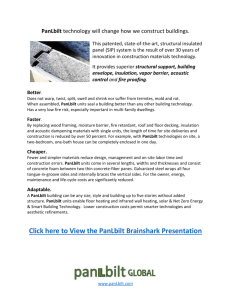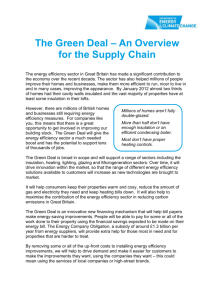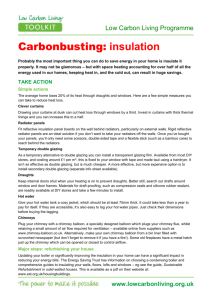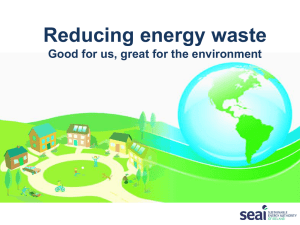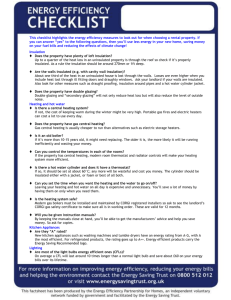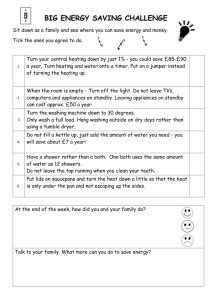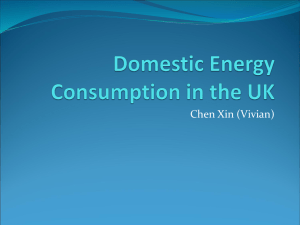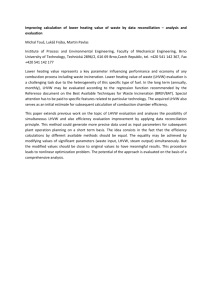CB2 Heating & Insulation Instant Expert
advertisement
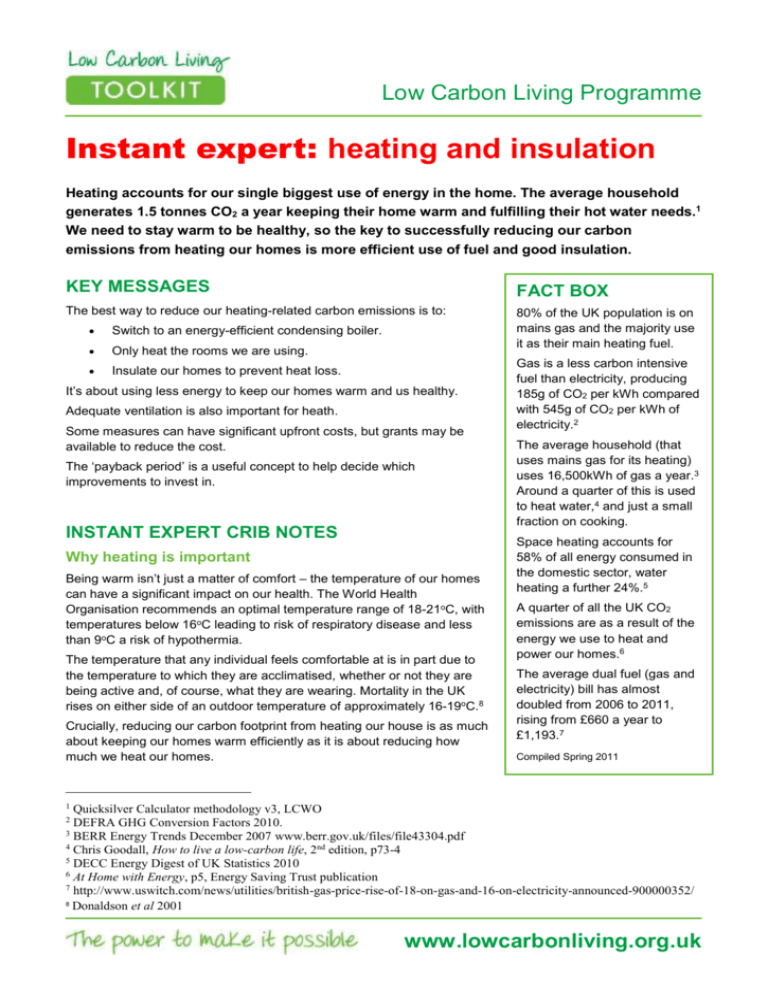
Low Carbon Living Programme Instant expert: heating and insulation Heating accounts for our single biggest use of energy in the home. The average household generates 1.5 tonnes CO2 a year keeping their home warm and fulfilling their hot water needs.1 We need to stay warm to be healthy, so the key to successfully reducing our carbon emissions from heating our homes is more efficient use of fuel and good insulation. KEY MESSAGES FACT BOX The best way to reduce our heating-related carbon emissions is to: 80% of the UK population is on mains gas and the majority use it as their main heating fuel. Switch to an energy-efficient condensing boiler. Only heat the rooms we are using. Insulate our homes to prevent heat loss. It’s about using less energy to keep our homes warm and us healthy. Adequate ventilation is also important for heath. Some measures can have significant upfront costs, but grants may be available to reduce the cost. The ‘payback period’ is a useful concept to help decide which improvements to invest in. INSTANT EXPERT CRIB NOTES Why heating is important Being warm isn’t just a matter of comfort – the temperature of our homes can have a significant impact on our health. The World Health Organisation recommends an optimal temperature range of 18-21oC, with temperatures below 16oC leading to risk of respiratory disease and less than 9oC a risk of hypothermia. The temperature that any individual feels comfortable at is in part due to the temperature to which they are acclimatised, whether or not they are being active and, of course, what they are wearing. Mortality in the UK rises on either side of an outdoor temperature of approximately 16-19oC.8 Crucially, reducing our carbon footprint from heating our house is as much about keeping our homes warm efficiently as it is about reducing how much we heat our homes. Gas is a less carbon intensive fuel than electricity, producing 185g of CO2 per kWh compared with 545g of CO2 per kWh of electricity.2 The average household (that uses mains gas for its heating) uses 16,500kWh of gas a year.3 Around a quarter of this is used to heat water,4 and just a small fraction on cooking. Space heating accounts for 58% of all energy consumed in the domestic sector, water heating a further 24%.5 A quarter of all the UK CO2 emissions are as a result of the energy we use to heat and power our homes.6 The average dual fuel (gas and electricity) bill has almost doubled from 2006 to 2011, rising from £660 a year to £1,193.7 Compiled Spring 2011 1 Quicksilver Calculator methodology v3, LCWO DEFRA GHG Conversion Factors 2010. 3 BERR Energy Trends December 2007 www.berr.gov.uk/files/file43304.pdf 4 Chris Goodall, How to live a low-carbon life, 2nd edition, p73-4 5 DECC Energy Digest of UK Statistics 2010 6 At Home with Energy, p5, Energy Saving Trust publication 7 http://www.uswitch.com/news/utilities/british-gas-price-rise-of-18-on-gas-and-16-on-electricity-announced-900000352/ 8 Donaldson et al 2001 2 www.lowcarbonliving.org.uk Trends The UK’s total domestic energy consumption has risen by 32% between 1970 and 2000. Within this time there have been some significant changes in the way we heat our homes, with major increases in the proportion of our power coming from gas (from 24% to 67% of the domestic fuel mix) and a large decrease in the popularity of coal (from 39% to just 3%). A big factor in this shift has been the increase in popularity of central heating. In 1970, less than a third of all houses had central heating – that had risen to 89% by 2000, the majority of which were powered by gas.9 The long-term overall increase in energy used for domestic heating is due to a number of factors:10 - The increase in overall number of households. A long-running tendency to heat our homes to a higher temperature (from 12C in 1970 to 18C in 2002). Heating more rooms and for longer periods, eg heating bedrooms and hallways. This upward trend is beginning to be balanced by more efficient boilers, improved insulation of homes, and consumer sensitivity to price rises. It is estimated that, had the savings through insulation and heating efficiency improvements from 1970 onwards not been made, then energy consumption in homes would be around twice current levels.11 Overall energy consumption is also weather-dependent. For example, the harsh UK weather in January and December 2010 resulted in a 15% increase in gas demand by the domestic sector from the previous year.12 How we heat our homes Mythbusting It is important to keep warm and healthy, however there are still ways we can change our use of our heating systems that will reduce fuel use. These include: Isn't it better for me to leave the heating on low while I am out the house, rather than turn it off, so that the house takes less time to heat up when I return home? Turning the thermostat down For most healthy adults, a room temperature of 18-21oC is sufficient. Over a period of weeks it is possible to acclimatise to the lower end of this range by shifting the thermostat down by half a degree a week. Thermostats are not always accurate and, depending where they are placed, may not be measuring the air temperature in your main living space. Use a room thermometer to check the actual temperature and adjust your heating accordingly. Turning the thermostat by one degree can save 10% in your annual fuel bill.13 Only heating rooms we use All too frequently we heat the whole of our homes, not just the rooms we are in. By installing Thermostatic Radiator Valves (TRVs) you can turn down radiators in unoccupied rooms. Taking an active approach to heating management Taking an active approach to heating our homes can have a big impact on the fuel we use, such as reprogramming the timer to reflect changing patterns of household occupancy, eg weekends and holidays or changes in the weather. Another simple change is to switch off your heating during milder periods so that you actively switch it on when needed. Answer: No! If you want your house to be readily heated up when you wake up in the morning or come in from an outing, you should use the timer/programmer to switch the heating on a suitable length of time beforehand. You can time how quickly your home heats up and cools down by switching the boiler on and measuring the time taken to reach a comfortable temperature. If this is, for example, 30 minutes then set the programmer to switch the heating on 30 minutes in advance of times when you know you will be waking up or arriving home. Leaving the heating on for any longer than this when you are out the house, even on a low setting, means that the boiler will be working continuously when the heating is not needed and all the energy it produces will be wasted. Source: Energy Saving Trust website 9 Energy Consumption in the UK, DECC ‘How warm is your home’ BBC News 3 March 2011 [online] viewed 8 July 2011 available at http://www.bbc.co.uk/news/magazine-12606943 11 DECC digest of Energy UK Statistics 2010, press release 12 DECC Quarterly Tables “Energy Trends” 30 June 2011 Update 13 Energy Saving Trust 10 2 www.lowcarbonliving.org.uk The impact of fuel choices There are a number of different fuels available to householders for ‘space’ heating (heating rooms). These include: - Gas – mains. - Gas – bottled (LPG). - Electricity. - Oil. - Coal and coal-based solid fuels. - Biomass, eg wood. - Hot water mains (known as district heating). Of these, natural gas is the most commonly used and cheapest option. It is also the least carbon intensive of the fossil fuel based options. Coal is the most carbon intensive. The carbon emissions associated with electric heating are high, around three times those of gas and twice those of oil, per unit of heat delivered. This is due to the high amount of waste heat that is a by-product at electricity-generating power stations. The lost heat also partially explains why the cost of electricity is so high compared to gas.14 The carbonbusting session on green energy will look at the carbon intensity of these fuels in more detail. Using fuel efficiently Whichever fuel you use, the way in which you burn it to create heat has a big impact on your ability to extract the maximum useful heat out of your fuel. The Energy Saving Trust website has detailed information about the different types of heating systems available: http://www.energysavingtrust.org.uk/Home-improvements-andproducts/Heating-and-hot-water Condensing boilers Modern condensing boilers are more efficient than older boilers. They convert more of the fuel into useful heat and lose less heat in water vapour. Modern condensing boilers operate at around 90% efficiency, compared to 55-75% efficiency for old-style boilers.15 According to the Energy Saving Trust, boilers account for around 60% of the CO2 emissions in a gas-heated home. They estimate that replacing an old G-rated boiler with a new, high-efficiency condensing boiler and improving your heating controls can result in annual savings of over one tonne of CO2. The current lifespan of a boiler is around 12 years, so fitting an A-rated high-efficiency condensing boiler with the correct heating and hot water controls can make a huge difference to your heating bills over time.16 Condensing boilers can be either heat-only or combination boilers. Changes in building regulations mean that new boilers installed in a domestic home should be condensing boilers except in a few rare circumstances. Wood-burning stoves Simply burning wood in a fireplace is a pretty inefficient use of fuel, but wood-burning stoves can help maximise the use of the heat generated. Wood is (arguably) a virtually carbon neutral energy source – we’ll look at this in more detail in the green energy carbonbusting session. Further information can be found at The Energy Saving Trust website and ClimateXchange website: http://climatex.org/articles/climate-change-info/wood-fuel-oxfordshire/ Solar gain A useful and sometimes overlooked source of heat is the sun. Even on a winter’s day, the sunshine can generate significant warmth. Opening curtains to let in the sunlight is a simple way of capturing this heat. ‘Passivhaus’ building techniques help maximise the capturing of heat from the sun, and combine this with extremely efficient insulation to result in dramatic reductions in the energy used to heat a home. 14 uswitch http://www.uswitch.com/heating/heating-fuel/#step2 Market Transformation Programme (2005) 16 http://www.est-eofe.org.uk/Home-improvements-and-products/Heating-and-hot-water 15 3 www.lowcarbonliving.org.uk Keeping the heat in Although we may not be able to achieve Passivhaus standards in our homes, there is much that can be done to improve the way our homes retain heat. Heat is lost through draughts, transmitted out of our home through the building fabric or via ‘thermal bridges’ – spots where heat is easily conducted to outside. Thermal imaging techniques can be used to take photos of building to highlight the areas of heat loss. In this section we cover the principles behind insulating key areas of the home – but not the practical details of carrying this out. Excellent guides for practical information on installing insulation, and advice on finding installers, is already available from a number of sources. These are listed at the end of this section. Key sources of heat loss The importance of ventilation The contribution made by various parts of the house to heat loss depends on their proportion to the overall surface area of the house, and how easily the materials they are made from lose heat. For example, in a semi-detached house, the walls and roof make up over 50% of the surface area of the house exposed to the outside. Insulating these areas can therefore, unsurprisingly, make a big difference to the heat lost by the house. Ventilation is responsible for around 20% of the cost of heating a home.17 But when insulating your home it’s crucial to retain some ventilation. Houses need to sustain enough airflow to refresh all the air in the house every hour to provide enough oxygen and keep inhabitants healthy, allow gas appliances to operate safely, and prevent condensation and mould growth. Mythbusting “There is no point in my switching off lights, TVs, and phone chargers during the winter because the ‘wasted’ energy they put out heats my home, so it’s not wasted.” This is true for a few people – and only during the winter – but it’s false for most. If your house is being heated by electricity through ordinary bar fires or blow heaters then, yes, it’s much the same as heating the house with any electricity-wasting appliances. But if you are in this situation, you should change the way you heat your house. Electricity is high-grade energy, and heat is low-grade energy. It’s a waste to turn electricity into heat. To be precise, if you make only one unit of heat from a unit of electricity, that’s a waste. Heaters called air-source heat pumps or ground-source heat pumps can do much better, delivering three or four units of heat for every unit of electricity consumed. They work like back-to-front refrigerators, pumping heat into your house from the outside air or ground. For the rest, whose homes are heated by fossil fuels or biofuels (such as wood), it’s a good idea to avoid using electrical gadgets as a heat source for your home. It’s better to burn the fossil fuel at home. The point is, if you use electricity from an ordinary fossil power station, more than half of the energy from the fossil fuel goes sadly up the cooling tower. Of the energy that gets turned into electricity, about 8% is lost in the transmission system. If you burn the fossil fuel in your home, more of the energy goes directly into making hot air for you and warming your home. Adapted from David MacKay, Sustainable Energy without the Hot Air, p71 17 Chris Goodall, How to live a low-carbon life, 2nd edition, p66, published by Earthscan 4 www.lowcarbonliving.org.uk Insulation options The Energy Saving Trust website18 gives an indication of the different insulation options available and the impact and cost of each option; this is based on a gas-heated, semi-detached house with three bedrooms, no insulation and single-glazed windows. Action Annual potential CO2 saving Approx. annual £ saving (3.67p per kWh) Cost to install Payback period External wall insulation 1.9 tonnes £385 £10,500£14,500 27-38 years Internal wall insulation 1.8 tonnes £365 £5,500-£8,500 14-23 years Loft insulation 0.7 tonnes £145 £150-£250 1-2 years Double glazing 650kg £130 £2,500-6,500 19-50 years Cavity wall insulation 560kg £110 £150-£250 1-2 year Secondary glazing 420kg £85 £600-800 7-9.5 years Floor insulation 240kg £50 £100 (DIY) Around 2 years Draft-proofing 120kg £25 £100 (DIY) 4 years Walls Cavity walls Houses built after around 1930 usually have a cavity wall – an air cavity between two brick layers. Around 40% of all housing stock has a cavity wall. Cavity wall insulation can greatly reduce heat loss from the building. A number of subsidies are available to householders wishing to insulate their cavity walls. ‘u-value’ This is a measure of how quickly heat is transmitted by a material. A material with a low u-value is slow to transmit heat and so is a good insulating material. Solid walls Prior to around 1930, houses were usually built with a solid wall construction. The walls of these houses are much more difficult – and expensive – to insulate. Options include: - External cladding or insulation – changes which may require planning permission - Adding an insulating layer internally to the wall. Either rigid insulation boards or a stud wall is erected inside the house. This can be bulky, resulting in significant lost of space. A thinner, but less effective solution is insulating wallpaper such as ‘Sempatap’, which is only around 1cm thick. - A key area for heat loss on external walls is behind radiators, where the heat they generate goes into the wall and leaks outside. Radiator panels which reflect the heat back into the room can be placed behind radiators. Lofts Around a quarter of all heat loss is up through the roof. The Energy Saving Trust now recommends that loft insulation is installed to a minimum depth of 270mm, so even if your loft is already insulated, it may require a top up. Installing loft insulation can, in some instances, be a simple DIY job (though do take care to insulate over water tanks and to leave a ventilation route for the roof space at the eaves – Energy Saving Trust publications and website give more information). It may be worth considering taking advantage of the many subsidised schemes that exist, especially if you have a hard-to-reach loft or would benefit from professional advice. 18 Energy Saving Trust website: http://www.energysavingtrust.org.uk/Energy-saving-assumptions, viewed 7 July 2011 and http://www.energysavingtrust.org.uk/Home-improvements-and-products/Home-insulation-glazing/Glazing 5 www.lowcarbonliving.org.uk Windows Double glazing Double glazing works by trapping a layer of insulating air between two panes of glass. Very efficient glazing units replace the air with inert gases, and glass is coated with a layer that allows light and heat in, but prevents heat loss out. Double glazing units can be expensive to install and in certain areas, eg conservation areas or listed buildings, there are additional regulations relating to double glazing. Systems vary enormously, so care should be taken when selecting products. The Energy Saving Trust Recommended product mark applies to double glazing products. Care should also be taken when selecting installers – the Energy Saving Trust website gives more information on this. Alternatives to double glazing include: Secondary glazing Either professionally-installed or DIY systems where a second pane of glass or plastic sheeting is fitted, trapping an insulating area of air. There are a number of different fixing systems which work with different types of window. A downside is that, when in place, some fixing systems can make it hard to open windows. Temporary film A cheaper, but less effective system is to install a temporary film over your window. This can be purchased at DIY stores and needs to be reinstalled each winter. Draft-proofing Old sash windows can be renovated to include draft-proofing strips, or DIY draft-proofing materials can be purchased at DIY stores. Floor insulation Insulation options will vary depending on the floor construction. Rugs or carpets and thick underlay can cut down draughts and form an insulating layer. Silicone sealant can be used to seal gaps between floorboards or around skirting. In suspended floors, insulating material can be fitted under the floorboards – but care needs to be taken to ensure sufficient ventilation is retained to prevent boards rotting. Draft-proofing A simple DIY job is to seek out and block draughts around the home. Look for these wherever there are breaks in the construction of the house – doorways and windows, loft hatches and between floorboards – as well as places where cables or pipework have been fitted through the external walls. Chimneys Plug your chimney with a chimney balloon, a specially designed balloon which plugs your chimney flue, whilst retaining a small amount of air flow required for ventilation – available online from suppliers such as www.chimney-balloon.co.uk. Alternatively, make your own chimney balloon from a bin liner filled with scrunched newspaper (but don’t forget to remove it if you have a fire!). Some old fireplaces have a metal hatch just up the chimney which can be opened or closed to control airflow. 6 www.lowcarbonliving.org.uk Hot water Around a fifth of the energy used for heating our homes is used to heat water. As with heating our homes, we can make significant savings by using less water, better insulation and more efficient heating methods. Using less The average person uses around 55 litres of hot water a day,19 the majority of which goes on baths and showers. Although showering generally uses less water than a bath, this can vary greatly depending on the length of shower and type of shower unit, with high pressure showers using up to 16 litres of water a minute. Lowering temperatures Heating water to a lower temperature – say 60C instead of 80C – will reduce the energy required and still be hot enough to remove the threat of Legionella 20 – however not all tanks and boilers have this option. Insulation Pipework and hot water tanks can be insulated very cheaply to prevent heat loss from the boiler and tank to the tap, although reaching some hot water pipes can prove difficult. Keeping cool In the UK we are usually concerned with keeping our homes warm, however keeping cool can be just as much of an issue for health and comfort. In hot countries – and, increasingly, even in the UK – air conditioning can be a significant use of energy. A well-insulated home is better at keeping cool as it keeps the heat out. Paying for home improvements Changing heating systems or improving home insulation can be a costly activity, and as the table on page 5 shows, can take many years to recoup in savings in fuel bills. A number of grants are available to help cover these costs. Many are available to everyone and sometimes you don’t even have to own the property you live in to be eligible. Some are funded by government, others by energy companies. As grants and schemes are frequently changing, the best place to look for current schemes is: The Energy Saving Trust website Grants and Discounts Database at www.energysavingtrust.org.uk, or call 0800 512 012 for free, independent and local energy-saving advice. Cocoon Your Home: www.cocoonyourhome.co.uk, tel: 0800 8048 777. Your local council website, eg: http://www.oxford.gov.uk/PageRender/decER/Grants_and_offers_occw.htm Watch out for the Green Deal, a new scheme to help householders fund major refurbishment work. Key definitions Comfort taking An effect whereby householders experience a lower energy-saving from an insulation intervention because they opt instead for a more comfortable living environment, for example, by leaving heating on for longer.21 Payback Payback, or the payback period, is the time it takes for savings (often, in this context, in energy bills) to overtake the initial capital outlay on installation of an energy-saving device or system.22 Fuel poverty Households are considered by the government to be in ‘fuel poverty’ if they would have to spend more than 10% of their household income on fuel to keep their home in a ‘satisfactory’ condition. It is thus a measure which compares income with what the fuel costs ‘should be’ rather than what they actually are.23 19 Chris Goodall, How to live a low-carbon life Energy Saving Trust website 21 Energy Saving Trust website: http://www.energysavingtrust.org.uk/Energy-saving-assumptions viewed 7 July 2011 22 http://www.bbc.co.uk/bloom/glossary.shtml 20 7 www.lowcarbonliving.org.uk FURTHER INFORMATION How to live a low-carbon life by Chris Goodall, published by Earthscan – The low-carbon bible. Energy Saving Trust website, in particular the following sections: Home Improvements and Products: www.energysavingtrust.org.uk/Home-improvements-and-products Housing Professionals: www.energysavingtrust.org.uk/business/Business/Housing-professionals Practical Refurbishment of solid-walled houses, published by Energy Saving Trust, 2006, available as a pdf from the Energy Saving Trust website. This work is part of the Low Carbon Living Toolkit and is licensed under a Creative Commons AttributionNonCommercial-ShareAlike 3.0 Unported License. If you have any questions or tips to suggest please email them to us at lowcarbon@hotmail.co.uk v 1.3 10/09/09 Whilst we have made every attempt to ensure the accuracy of this leaflet, this information should not be relied upon as a substitute for formal advice. LCWO will not be responsible for any loss, however arising, from the use of, or reliance on this information. Low Carbon West Oxford is a registered charity 1135225. 23 Definition from the Poverty Site: www.poverty.org.uk 8 www.lowcarbonliving.org.uk
